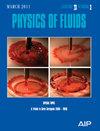考虑粘度温度和压力效应的柱塞副润滑机理研究
IF 4.1
2区 工程技术
Q1 MECHANICS
引用次数: 0
摘要
针对航空柱塞泵在高速、高压等恶劣工况下运行时摩擦磨损严重、泄漏量大等关键问题,本文对航空柱塞泵的润滑特性进行了研究。为了改善柱塞泵的润滑性能,提高其工作效率和使用寿命,建立了柱塞副油膜在压力流、剪切流和油缸弹性变形作用下,在粘度温度和压力共同作用下的压力、厚度和泄漏量方程。采用有限差分法分析了分别考虑粘温和粘压影响、只考虑粘温或粘压影响、不考虑粘温和粘压影响这四种不同条件下柱塞副的润滑特性和泄漏情况。结果,在粘温和粘压的影响下,当温度从 20 ℃ 升至 60 ℃ 时,油膜压力增加,厚度下降较快。当温度从 60 ℃ 升至 120 ℃ 时,油膜压力增加,厚度减小得较慢。当柱塞对的接触长度从 17 mm 增加到 37 mm 时,泄漏率减小得更快,当大于 37 mm 时,泄漏率减小得更慢。得出以下结论:润滑油的粘度受温度和压力的影响很大。随着温度和压力的升高,粘度呈双曲线减小和增大,考虑粘度温度和压力影响时的最大油膜压力明显大于不考虑粘度温度和压力时的最大油膜压力,最小油膜厚度远小于不考虑粘度温度和压力时的最小油膜厚度。考虑粘度温度和压力影响时的泄漏曲线与只考虑单一因素或不考虑粘度温度和压力影响时的泄漏曲线明显不同。四种情况下的泄漏量分别为:考虑粘温效应、考虑粘温和粘压效应、不考虑粘温和粘压效应、考虑粘压效应。本研究可为柱塞泵中柱塞副的精确理论设计和安全稳定运行提供参考。本文章由计算机程序翻译,如有差异,请以英文原文为准。
Research on lubrication mechanism of plunger pair considering viscosity temperature and pressure effect
Aiming at the key problems such as serious friction and wear and large leakage of aviation piston pumps operating under high-speed and high-pressure harsh conditions, the lubrication characteristics of aviation plunger pumps are studied in this paper. In order to improve the lubrication performance of the plunger pump, as well as its working efficiency and service life, the equations of pressure, the thickness, and the leakage of the plunger pair oil film under the combined actions of viscosity temperature and pressure under pressure flow, shear flow, and cylinder elastic deformation are established. The finite difference method is used to analyze the lubrication characteristics and the leakage of the plunger pair under these four different conditions: considering, respectively, the effect of viscosity temperature and pressure, only considering the effect of viscosity temperature or viscosity pressure, without considering the effect of viscosity temperature and viscosity pressure. As a result, coupled by the effects of viscosity temperature and viscosity pressure, when the temperature increases from 20 to 60 °C, the oil film pressure increases, and the thickness decreases faster. When the temperature increases from 60 to 120 °C, the oil film pressure increases and the thickness decreases slower When the contact length of the plunger pair increases from 17 to 37 mm, the leakage ratio decreases more rapidly, and when it is greater than 37 mm, it decreases more slowly. The following conclusions were obtained: the viscosity of lubricating fluid is greatly affected by temperature and pressure. The viscosity decreases and increases hyperbolically with the increase in temperature and pressure, the maximum oil film pressure when considering the effect of viscosity temperature and pressure was significantly greater than that without considering the viscosity temperature and pressure, and the minimum oil film thickness was much smaller than that without considering the viscosity temperature and pressure. The leakage curve when considering the viscosity temperature and pressure effect was obviously different from when only considering a single factor or not considering the viscosity temperature and pressure effect. The magnitude of leakage in the four cases is: considering the viscosity temperature effect, considering the viscosity temperature and pressure effect, not considering the viscosity temperature and pressure effect, and considering the viscosity pressure effect. This study can provide a reference for the accurate theoretical design and safe and stable operation of the plunger pair in the plunger pump.
求助全文
通过发布文献求助,成功后即可免费获取论文全文。
去求助
来源期刊

Physics of Fluids
物理-力学
CiteScore
6.50
自引率
41.30%
发文量
2063
审稿时长
2.6 months
期刊介绍:
Physics of Fluids (PoF) is a preeminent journal devoted to publishing original theoretical, computational, and experimental contributions to the understanding of the dynamics of gases, liquids, and complex or multiphase fluids. Topics published in PoF are diverse and reflect the most important subjects in fluid dynamics, including, but not limited to:
-Acoustics
-Aerospace and aeronautical flow
-Astrophysical flow
-Biofluid mechanics
-Cavitation and cavitating flows
-Combustion flows
-Complex fluids
-Compressible flow
-Computational fluid dynamics
-Contact lines
-Continuum mechanics
-Convection
-Cryogenic flow
-Droplets
-Electrical and magnetic effects in fluid flow
-Foam, bubble, and film mechanics
-Flow control
-Flow instability and transition
-Flow orientation and anisotropy
-Flows with other transport phenomena
-Flows with complex boundary conditions
-Flow visualization
-Fluid mechanics
-Fluid physical properties
-Fluid–structure interactions
-Free surface flows
-Geophysical flow
-Interfacial flow
-Knudsen flow
-Laminar flow
-Liquid crystals
-Mathematics of fluids
-Micro- and nanofluid mechanics
-Mixing
-Molecular theory
-Nanofluidics
-Particulate, multiphase, and granular flow
-Processing flows
-Relativistic fluid mechanics
-Rotating flows
-Shock wave phenomena
-Soft matter
-Stratified flows
-Supercritical fluids
-Superfluidity
-Thermodynamics of flow systems
-Transonic flow
-Turbulent flow
-Viscous and non-Newtonian flow
-Viscoelasticity
-Vortex dynamics
-Waves
 求助内容:
求助内容: 应助结果提醒方式:
应助结果提醒方式:


